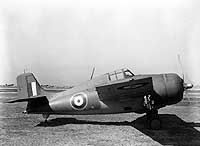
A modified version of the U.S. Navy's F4F, the Grumman Model G-36A provided the Royal Navy with its first high-performance single-seat monoplane carrier fighter. Named "Martlet I" in British service, these 81 aircraft had originally been ordered by France and were taken over by the British after France surrendered. Powered by 1,240 horsepower Wright "Cyclone" radial engines, the first "Martlets" entered service in September 1940, and achieved the first "kill" for any American-built fighter in British service on Christmas day of that year, when a German Ju-88 was forced down near Scapa Flow.
Several other versions of the design followed in 1941. The 100 "Martlet II" and 30 "Martlet III" types had 1,200 horsepower Pratt & Whitney "Twin Wasp" engines, like the American F4Fs. Most "Martlet IIs" also had folding wings. These early "Martlets" had considerable combat service, flying from shore bases and from aircraft carriers, including the pioneer escort carrier, HMS Audacity. Very maneuverable by European standards, and heavily armed, they were a serious threat to enemy aircraft.
The "Cyclone" powered Grumman F4F-4B, a type built solely for transfer to the British, became the "Martlet IV". Like later versions of the design, these 220 planes were provided through Lend-Lease, rather than by sale, and were delivered starting in 1942. Next in the series were over 300 "Martlet Vs", identical to the U.S. Navy's General Motors-built FM-1, with Pratt & Whitney engines. Surviving units of these two types were redesignated "Wildcat IV" and "Wildcat V" in January 1944. There were also 340 "Wildcat VI" fighters, the equivalent to the USN's FM-2. The first of these arrived in 1944.
The later British "Martlets" and "Wildcats" were extensively used at sea, primarily based on escort carriers though some were also carried aboard fleet carriers. In addition to anti-submarine work, teamed with "Swordfish" strike aircraft, they participated in amphibious operations in the Mediterranean and Normandy, helped make oceanic aerial reconnaissance unhealthy for the German air force and successfully competed with enemy fighters for control of the air over European shores.
For general characteristics of this type of aircraft, see the entries for U.S. Navy F4F and FM-2 "Wildcat" fighters.
This page features all our views of Royal Navy "Martlet" and "Wildcat" fighters.
For pictorial coverage of U.S. Navy "Wildcat"
type fighters, see:
| If you want higher resolution reproductions than the digital images presented here, see: "How to Obtain Photographic Reproductions." |
Click on the small photograph to prompt a larger view of the same image.
|
Photo #: SC 169213 British Royal Navy "Martlet II" fighter Parked at La Senia air base, Oran, Algeria, 14 December 1942. Photograph from the Army Signal Corps Collection in the U.S. National Archives. Online Image: 77KB; 740 x 610 pixels Reproductions of this image may also be available through the National Archives photographic reproduction system. |
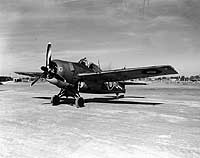 |
|
Photo #: SC 169214 British Royal Navy "Martlet II" fighter (Serial # AJ148) Parked at La Senia air base, Oran, Algeria, 14 December 1942. Photograph from the Army Signal Corps Collection in the U.S. National Archives. Online Image: 75KB; 740 x 605 pixels Reproductions of this image may also be available through the National Archives photographic reproduction system. |
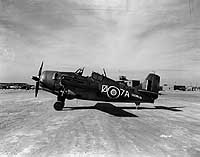 |
|
Photo #: NH 89675 British Royal Navy "Martlet IV" fighter, (Grumman F4F-4B) At Naval Air Station, Anacostia, D.C., after application of British markings. Original photograph is dated 21 April 1942. This aircraft is FN100, the first "Martlet IV" Official U.S. Navy Photograph, from the collections of the Naval History and Heritage Command. Online Image: 68KB; 740 x 565 pixels |
 |
|
Photo #: NH 89676 British Royal Navy "Martlet IV" fighter, (Grumman F4F-4B) At Naval Air Station, Anacostia, D.C., after application of British markings. Original photograph is dated 21 April 1942. This aircraft is FN100, the first "Martlet IV" Official U.S. Navy Photograph, from the collections of the Naval History and Heritage Command. Online Image: 77KB; 740 x 535 pixels |
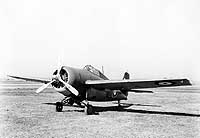 |
|
Photo #: 80-G-K-15977 (Color) British Royal Navy WREN Tears the U.S. "Star" circle from the fuselage of a Grumman FM-1 "Wildcat" fighter, revealing British Fleet Air Arm markings underneath, as the plane is transferred to the Royal Navy to become a "Martlet V". A U.S. Navy sailor is paying very close attention to particular aspects of the process. The ceremony took place at Naval Air Station, Quonset Point, Rhode Island, in September 1943. The plane bears British serial number JV-331. Photographed by Lieutenant Charles Fenno Jacobs, USNR. Official U.S. Navy Photograph, now in the collections of the National Archives. Online Image: 53KB; 740 x 605 pixels Reproductions of this image may also be available through the National Archives photographic reproduction system. |
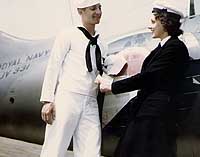 |
|
Photo #: KN-20381 (Color) "Taks Force of Two Navies" Watercolor by Dwight Shepler, USNR, 1943, depicting U.S. and British warships in the Pentlant Firth during an operation toward the Norwegian coast, coincident with the Sicily invasion, July 1943. USS Alabama (BB-60) is in the lead, followed by HMS Illustrious and HMS King George V. Three British carrier-based fighters (two "Seafires" and a "Martlet") are overhead. Courtesy of the U.S. Navy Art Collection, Washington, DC. Official U.S. Navy Photograph. Online Image: 91KB; 740 x 520 pixels Reproductions of this image may also be available through the National Archives photographic reproduction system as Photo # 428-KN-20381 |
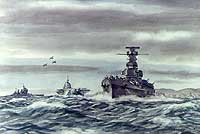 |
For pictorial coverage of U.S. Navy "Wildcat"
type fighters, see:
NOTES:
| If you want higher resolution reproductions than the digital images presented here, see: "How to Obtain Photographic Reproductions." |
Page made 22 January 2001
Coding updated 6 May 2009